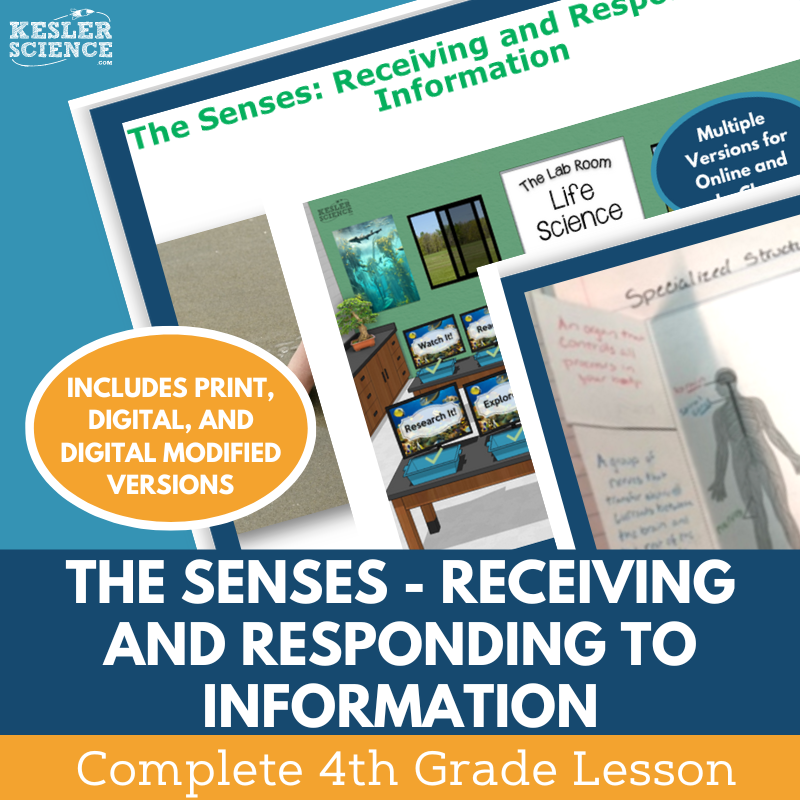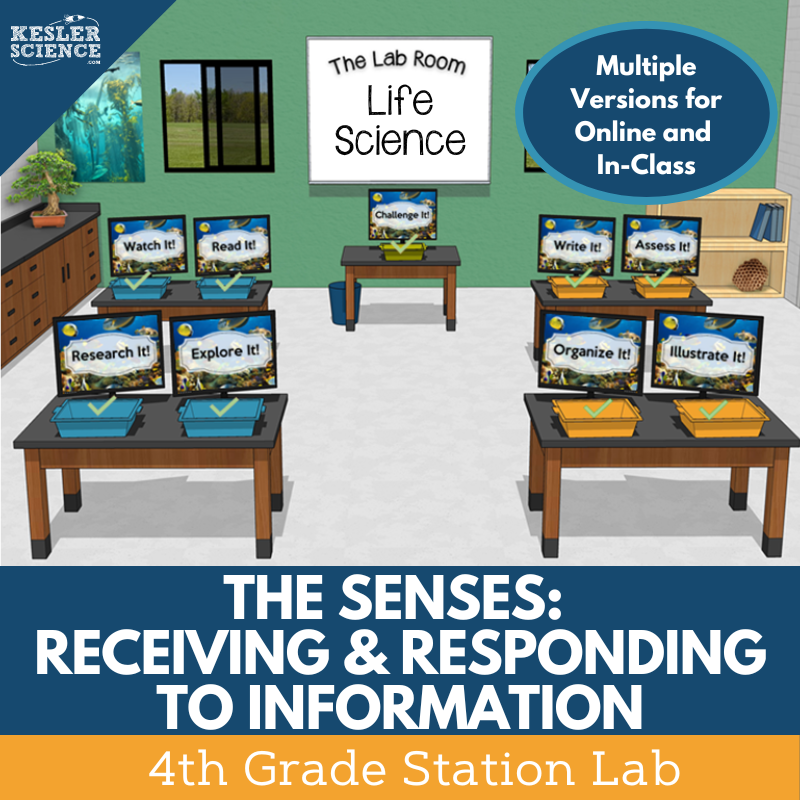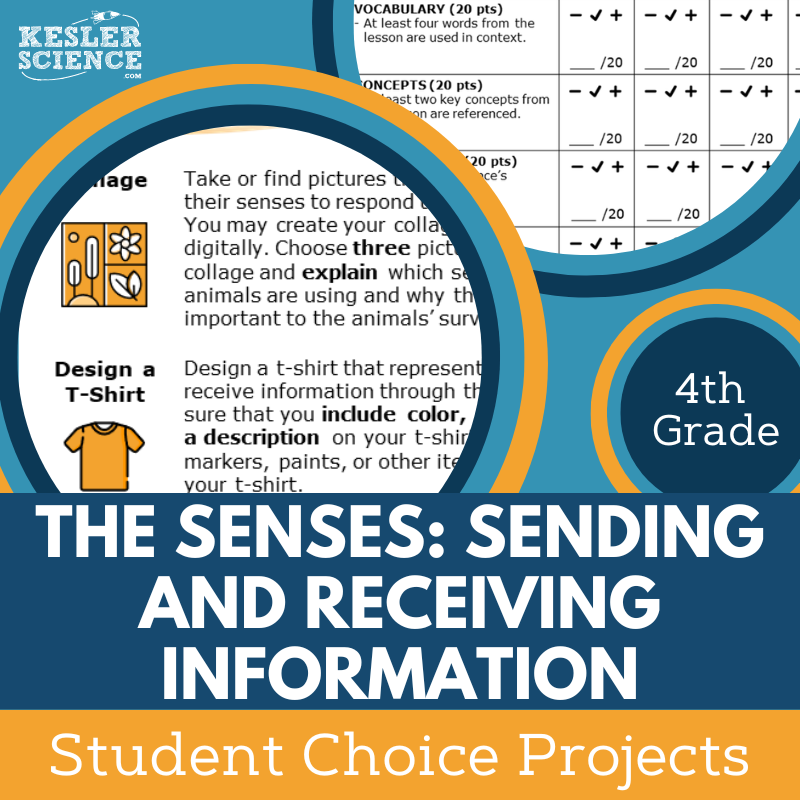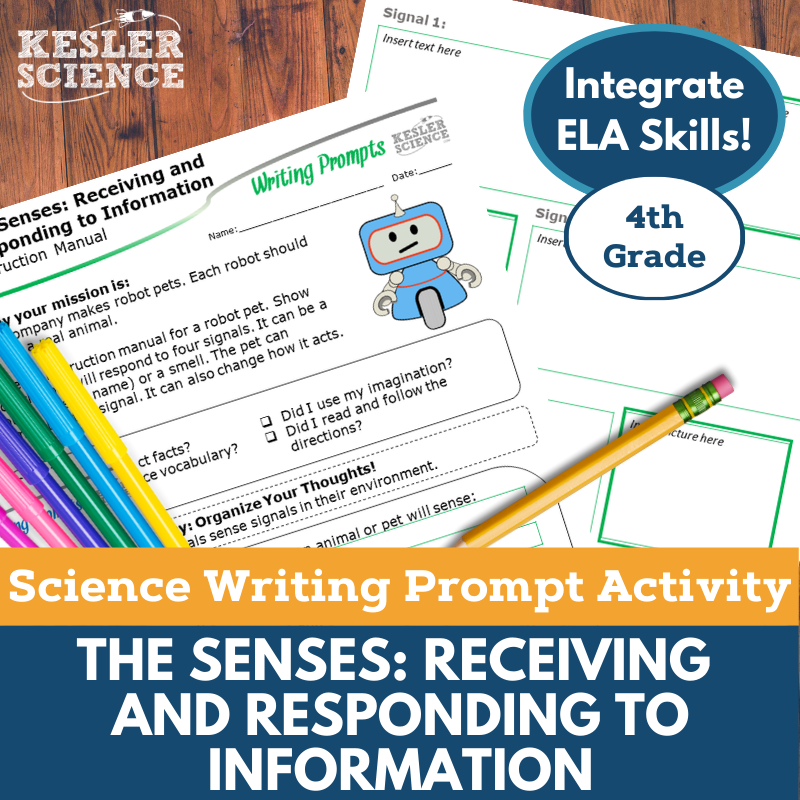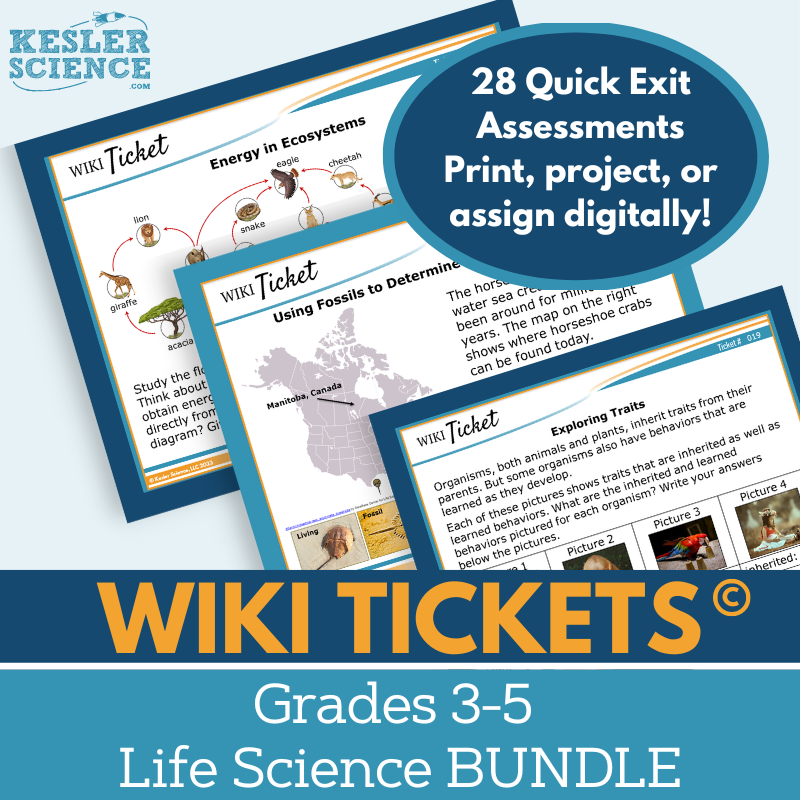Animal Senses Activities for 4th Grade Science
Help students explore how senses receive and respond to information with this engaging 5E lesson. The resources below will give students a comprehensive understanding of animal senses. All of the following materials are also included in the Kesler Science Membership.
The Kesler Science 5E Lesson on the senses—receiving and responding to information—provides a comprehensive, student-led learning experience with differentiated materials and multimodal activities. This life science unit includes editable presentations, worksheets, choice projects, and assessments, requiring little to no prep. It aligns with NGSS 4-LS-1-2 and supports flexible learning in both digital and printable formats, with Spanish translations of key resources.
Following the 5E Model, students engage with word wall cards and class discussions before exploring the topic through a differentiated, nine-station lab. Input stations include hands-on experiments, reading passages in English and Spanish, research tasks, and videos. Output stations allow students to categorize, write, illustrate, and assess their understanding. A bonus challenge station provides extension activities.
The lesson continues with editable PowerPoints, interactive notebooks, and note-taking templates for explanation. Students elaborate through choice projects, and evaluation includes STAAR 2.0-aligned assessments, review questions, and discussion worksheets. Designed for both in-person and virtual learning, this resource ensures an engaging, flexible approach to teaching the senses.
The Kesler Science 5E Lesson on the senses—receiving and responding to information—provides a comprehensive, student-led learning experience with differentiated materials and multimodal activities. This life science unit includes editable presentations, worksheets, choice projects, and assessments, requiring little to no prep. It aligns with NGSS 4-LS-1-2 and supports flexible learning in both digital and printable formats, with Spanish translations of key resources.
Following the 5E Model, students engage with word wall cards and class discussions before exploring the topic through a differentiated, nine-station lab. Input stations include hands-on experiments, reading passages in English and Spanish, research tasks, and videos. Output stations allow students to categorize, write, illustrate, and assess their understanding. A bonus challenge station provides extension activities.
The lesson continues with editable PowerPoints, interactive notebooks, and note-taking templates for explanation. Students elaborate through choice projects, and evaluation includes STAAR 2.0-aligned assessments, review questions, and discussion worksheets. Designed for both in-person and virtual learning, this resource ensures an engaging, flexible approach to teaching the senses.
Engage your 4th-grade students with this interactive, student-led station lab on The Senses: Receiving and Responding to Information. Designed to promote independent learning, this life science lesson allows students to construct arguments about how plants and animals have internal and external structures that support survival, growth, behavior, and reproduction.
The lab includes nine modular stations, each featuring differentiated, multimodal activities that encourage exploration and knowledge application. Input stations introduce key concepts through experiments, research tasks, reading passages available in English and Spanish, and videos. Output stations allow students to demonstrate their understanding through organizing information, creating illustrations, writing responses, and completing assessments. A bonus challenge station offers extension activities for early finishers.
This flexible resource includes all necessary signage, literature, resources, and task cards for small-group or independent work. Digital versions are available for virtual learning, ensuring accessibility in any classroom setting.
Engage your 4th-grade students with this interactive, student-led station lab on The Senses: Receiving and Responding to Information. Designed to promote independent learning, this life science lesson allows students to construct arguments about how plants and animals have internal and external structures that support survival, growth, behavior, and reproduction.
The lab includes nine modular stations, each featuring differentiated, multimodal activities that encourage exploration and knowledge application. Input stations introduce key concepts through experiments, research tasks, reading passages available in English and Spanish, and videos. Output stations allow students to demonstrate their understanding through organizing information, creating illustrations, writing responses, and completing assessments. A bonus challenge station offers extension activities for early finishers.
This flexible resource includes all necessary signage, literature, resources, and task cards for small-group or independent work. Digital versions are available for virtual learning, ensuring accessibility in any classroom setting.
The Senses: Sending and Receiving Information Student Choice Projects lesson allows 4th grade students to select a project that aligns with their preferred output style. A project page outlines six student-led options plus a “design your own” project, with an editable rubric for teacher, peer, or self-assessment.
These flexible, multimodal projects provide creative ways for students to demonstrate their understanding. Two versions of the project page support differentiation, offering modified options for students needing remediation and challenge options for advanced learners. Teachers can adjust the rubric to fit grading needs.
The projects use standard classroom supplies like paper, markers, and scissors, with many options available for digital completion.
The Senses: Sending and Receiving Information Student Choice Projects lesson allows 4th grade students to select a project that aligns with their preferred output style. A project page outlines six student-led options plus a “design your own” project, with an editable rubric for teacher, peer, or self-assessment.
These flexible, multimodal projects provide creative ways for students to demonstrate their understanding. Two versions of the project page support differentiation, offering modified options for students needing remediation and challenge options for advanced learners. Teachers can adjust the rubric to fit grading needs.
The projects use standard classroom supplies like paper, markers, and scissors, with many options available for digital completion.
The Senses: Receiving and Responding to Information science writing activity engages 4th-grade students in an instruction manual-style exercise to reinforce their understanding of how animals receive, process, and respond to information through their senses. Designed for both print and digital use, this TEKS- and NGSS-aligned activity supports in-person and virtual learning while encouraging science reasoning and writing skills.
This resource includes teacher directions with answer guides and rubrics, projection and print handouts, half-sheet options for interactive notebooks, and a digital version in PowerPoint and Google Slides. It works well as a cross-curricular activity, pre-test assessment, student choice project, or enrichment for early finishers. Ideal for extra credit, make-up work, or differentiation, this writing prompt fosters engagement and creativity while reinforcing key life science concepts.
The Senses: Receiving and Responding to Information science writing activity engages 4th-grade students in an instruction manual-style exercise to reinforce their understanding of how animals receive, process, and respond to information through their senses. Designed for both print and digital use, this TEKS- and NGSS-aligned activity supports in-person and virtual learning while encouraging science reasoning and writing skills.
This resource includes teacher directions with answer guides and rubrics, projection and print handouts, half-sheet options for interactive notebooks, and a digital version in PowerPoint and Google Slides. It works well as a cross-curricular activity, pre-test assessment, student choice project, or enrichment for early finishers. Ideal for extra credit, make-up work, or differentiation, this writing prompt fosters engagement and creativity while reinforcing key life science concepts.
The WIKI Tickets© Life Science Set provides 28 engaging formative assessments for 3rd–5th grade science, available in five formats: a full-screen display for projection, three printable handout versions, and an interactive digital version compatible with PowerPoint and Google Slides. These assessments align with NGSS and TEKS standards, ensuring comprehensive coverage with at least one ticket per standard.
Designed for flexibility, WIKI Tickets© can be used in both in-person and virtual learning environments. Topics covered include animal groups for survival, changes in ecosystems, energy flow in food webs, inherited traits, fossil evidence, the senses, and more. A bonus table of contents file is included for easy alignment reference.
These colorful assessments serve as exit tickets, bellringers, or quick checks on student understanding. They can be projected for class discussion, printed for written responses, or assigned digitally for individual work. WIKI Tickets© provide a versatile, engaging way to gauge student progress in life science.
The WIKI Tickets© Life Science Set provides 28 engaging formative assessments for 3rd–5th grade science, available in five formats: a full-screen display for projection, three printable handout versions, and an interactive digital version compatible with PowerPoint and Google Slides. These assessments align with NGSS and TEKS standards, ensuring comprehensive coverage with at least one ticket per standard.
Designed for flexibility, WIKI Tickets© can be used in both in-person and virtual learning environments. Topics covered include animal groups for survival, changes in ecosystems, energy flow in food webs, inherited traits, fossil evidence, the senses, and more. A bonus table of contents file is included for easy alignment reference.
These colorful assessments serve as exit tickets, bellringers, or quick checks on student understanding. They can be projected for class discussion, printed for written responses, or assigned digitally for individual work. WIKI Tickets© provide a versatile, engaging way to gauge student progress in life science.
Year-Round Resources
These year-round activities will increase your students' understanding of many middle school science topics. All of these activities are also included in the Kesler Science Membership.
Visual Data & Graphing
You're not alone if your students struggle with understanding graphs, charts, and tables. It's a skill that takes an enormous amount of practice. This resource will help students build a strong foundation in analyzing data and creating their own data visualizations.
Bell Ringers and Warm-Ups
These middle school science bell ringers are an excellent way to engage your students as soon as they walk into your classroom. This comprehensive FULL YEAR resource includes everything you need to start off each science class with an interesting warm-up activity.
Review Board Games
Each game board has been carefully designed to keep students engaged. There are 10 different action spaces on each board and dozens of question cards. All of the actions are related to science concepts and keep the students motivated throughout the game.
Each game is ready to play. Simply print out the board and the cards and let the students enjoy reviewing nine different units.
Essential Questions and Standards
Below are the essential questions and standards associated with the lessons and activities included in the animal senses unit. This topic is only one of more than 100 middle school science topics included in the Kesler Science Membership.
-
Describe the ways in which we receive different types of information.
-
What has to happen in the body for animals to use the information they get from their environment?
-
NGSS - 4-LS1-2 Animal Senses
Kesler Science Membership
Imagine never having to search for another middle school science lesson again. The membership gives you access to ALL of the Kesler Science products in one place (Yes, including everything above).
Say goodbye to long hours of lesson prep.

